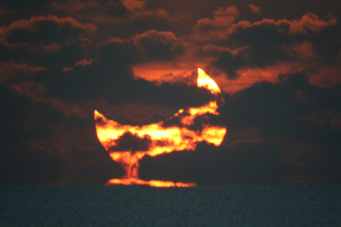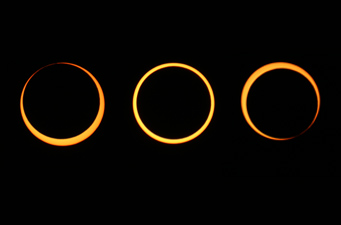
Veteran eclipse chaser Michael Gill captured this dramatic view of the Sun rising partially eclipsed last September 22nd from Kourou, French Guiana. He used a Celestron C90 f/11 telescope coupled to a Canon EOS 350D digital SLR camera for this unfiltered snapshot. Note how the atmosphere distorted the solar image.
Michael Gill
Guyana, Surinam, and French Guiana were the places to be to see last Friday's annular eclipse of the Sun. These small tropical countries on the northern coast of South America were the only solid ground touched by the path of annularity at sunrise that day; the rest of its narrow, 13,800-kilometer-long track traversed the open waters of the South Atlantic. Much of South America and West Africa got to see a partial eclipse.
Michael Gill of Birmingham, England, who moderates the Solar Eclipse Mailing List (SEML), traveled to the Pointe des Roches beach in Kourou, French Guiana, to witness the event. "The sunrise actually stole the show at this eclipse," he reported. "The mirage effects with the partially eclipsed Sun rising out of the Atlantic were more photogenic than the annular phase!" Annularity here lasted 5 minutes 42 seconds, with the Sun standing 8° above the eastern horizon against a clear, deep-blue sky.
Joining Gill that morning were scores of local residents, schoolchildren, and eclipse enthusiasts, including Val and Andrew White. "At around 6:19 [a.m.] the Sun peeped above the horizon and gradually rose through the low cloud, creating a fantastic effect with the sea horizon (known variously as Etruscan Vase, Omega Effect, or Inferior Mirage)," noted Andrew in their Web site. "There was a large local gathering for the eclipse, most clutching solar filters (which were given out free at some of the village health centres). Afterwards, not as many folks hung around for 4th contact, but there were a dedicated few who did. . . . After the eclipse, it was a mad dash to the Kourou space centre for our guided tour."

Michael Gill recorded (from left) the annular eclipse's second contact, midpoint, and third contact using the same setup as for his sunrise photo. For this sequence, he shot them through a Thousand Oaks solar filter.
Michael Gill
German astronomy writer and frequent S&T contributor Daniel Fischer, who was also in Kourou, said that "the seconds leading up to — and then again out of — annularity are arguably the most dramatic moments of an annular eclipse. Even before the [Sun's] horns touch, photospheric light pops through lunar valleys and causes bright beads of light — the famous Baily's Beads — [to form] in between them, which then grow to a bridge of light, closing the ring." He also added that last Friday's annulus "was the most perfect one I had ever seen." You can read Fischer's full report online at this site.
For more pictures of the eclipse, you can also visit Jörg Schoppmeyer's Web site.
The next annular eclipse will take place on February 7, 2008, over Antarctica.
 0
0
Comments
You must be logged in to post a comment.